
Knee Replacement Implants
During knee replacement surgery, an orthopaedic surgeon will resurface your damaged knee with artificial components, called implants.
There are many different types of implants. The brand and design used by your doctor or hospital depends on many factors, including:
- Your needs, based on your knee problem and knee anatomy, as well as your age, weight, activity level, and general health
- Your doctor's experience and familiarity with the device
- The cost and performance record of the implant
Your surgeon will discuss with you the type of implant that will be used for your knee replacement surgery.
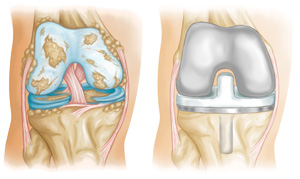 In total knee replacement, damaged bone and cartilage are removed and replaced with metal components that recreate the surface of the joint.
Implant Components
In total knee replacement, damaged bone and cartilage are removed and replaced with metal components that recreate the surface of the joint.
Implant Components
Implants are made of metal alloys, ceramic material, or strong plastic parts. Up to three bone surfaces may be replaced in a total knee replacement:
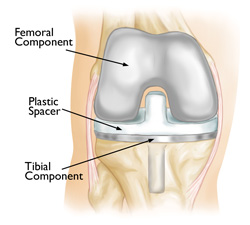
A total knee replacement implant.
- The lower end of the femur. The metal femoral component curves around the end of the femur (thighbone). It is grooved so the kneecap can move up and down smoothly against the bone as the knee bends and straightens.
- The top surface of the tibia. The tibial component is typically a flat metal platform with a cushion of strong, durable plastic, called polyethylene. Some designs do not have the metal portion and attach the polyethylene directly to the bone. For additional stability, the metal portion of the component may have a stem that inserts into the center of the tibia bone.
- The back surface of the patella. The patellar component is a dome-shaped piece of polyethylene that duplicates the shape of the patella (kneecap). In some cases, the patella does not need to be resurfaced.
Components are designed so that metal always borders with plastic, which provides for smoother movement and results in less wear of the implant.
Implant Designs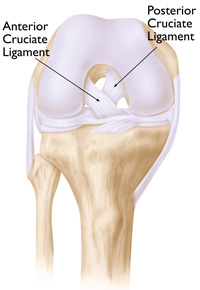 In a healthy knee, ligaments support the joint.
In a healthy knee, ligaments support the joint.
For simplicity, the knee is considered a "hinge" joint because of its ability to bend and straighten like a hinged door. In reality, the knee is much more complex because the bone surfaces actually roll and glide as the knee bends.
Current implant designs recognize the complexity of the joint and more closely mimic the motion of a normal knee. For example, ligaments keep the joint stable in a healthy knee. Some implant designs preserve the patient's own ligaments, while others substitute for them.
Several manufacturers make knee implants and there are more than 150 designs on the market today.
Gender-specific implants. Many manufacturers have developed components for the end of the thighbone which more closely match the average woman's knee. At this time, there is no research to show that "gender specific" implants last longer or provide better function than standard implants.
Posterior-Stabilized Designs
One of the most commonly used type of implant in total knee replacement is a posterior-stabilized component. In this design, the cruciate ligaments are removed and parts of the implant substitute for the posterior cruciate ligament (PCL).
The tibial component has a raised surface with an internal post that fits into a special bar (called a cam) in the femoral component. These components work together to do what the PCL does: prevent the thighbone from sliding forward too far on the shinbone when you bend your knee.
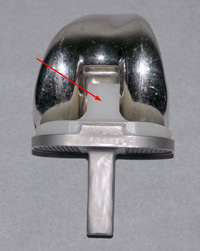 Parts of a posterior-stabilized implant (arrow) replace the PCL.
Parts of a posterior-stabilized implant (arrow) replace the PCL.
Cruciate-Retaining Designs
As the name implies, the posterior cruciate ligament is kept with this implant design (the anterior cruciate ligament is removed). Cruciate-retaining implants do not have the center post and cam design. This implant may be appropriate for a patient whose posterior cruciate ligament is healthy enough to continue stabilizing the knee joint.
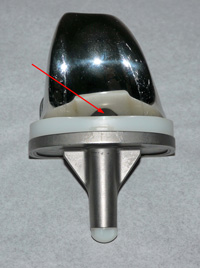 A cruciate-retaining component is designed with grooves to accommodate a patient's PCL.
A cruciate-retaining component is designed with grooves to accommodate a patient's PCL.
Bicruciate-Retaining Designs
In most total knee replacement procedures, the anterior cruciate ligament is removed to allow for precise placement of the implant. In bicruciate-retaining designs, both the anterior and posterior cruciate ligaments are kept. The rationale for this type of design is that by saving both ligaments, the knee will function and feel more like a non-replaced knee.
Bicruciate-retaining components are relatively new to the market and there are not yet many studies that demonstrate the pros and cons of this design.
Unicompartmental Implants
Although replacing the total knee joint is the most common procedure, some people can benefit from just a partial knee replacement.
If only one side of the knee joint is damaged, smaller implants can be used (unicompartmental knee replacement) to resurface just that side.
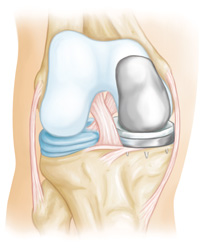 In a unicompartmental (partial) knee replacement, only the damaged part of the knee is replaced.
Types of Tibial Components
In a unicompartmental (partial) knee replacement, only the damaged part of the knee is replaced.
Types of Tibial Components
Fixed-Bearing Implants
Most patients get a fixed-bearing implant. In this design, the polyethylene of the tibial component is attached firmly to the metal implant beneath. The femoral component then rolls on this cushioned surface.
Mobile-Bearing Implants
In a mobile-bearing knee the polyethylene insert can rotate short distances inside the metal tibial tray. This is designed to allow patients a few degrees of greater rotation to the medial and lateral sides of their knee.
Fixed- vs. Mobile-Bearing Implants
Durability. In some cases, excessive activity and/or extra weight can cause a fixed-bearing prosthesis to wear down more quickly. Worn components can loosen from the bone and cause pain. Loosening is a major reason some artificial joints fail.
If you are younger, more active, and/or overweight, your doctor may recommend a rotating platform/mobile-bearing knee replacement. Although these implants have been designed for potentially longer performance with less wear, research has not yet established improved durability or function with mobile-bearing implants.
Soft-tissue support. Mobile-bearing knee implants require more support from soft tissues, such as the ligaments surrounding the knee. If the soft tissues are not strong enough, mobile-bearing knees are more likely to dislocate.
Cost. Mobile-bearing implants may cost more than fixed-bearing implants.
Implant MaterialsThe metal parts of the implant are made of titanium or cobalt-chromium based alloys. The plastic parts are made of ultra high molecular weight polyethylene. Some implants are made of ceramics or ceramic/metal mixtures. Whether metal or ceramic, implants weigh between 15 and 20 ounces, depending on the size selected.
Material Criteria
The construction materials used must meet several criteria:
- They must be biocompatible; that is, they can be placed in the body without creating a rejection response.
- They must be able to duplicate the knee structures they are intended to replace. For example, they are strong enough to take weightbearing loads, flexible enough to bear stress without breaking, and able to move smoothly against each other as required.
- They must be able to retain their strength and shape for a long time.
There are different types of fixation used to connect knee implants to the bone.
- Cemented fixation. Implants are most commonly held in place with a fast-curing bone cement (polymethylmethacrylate).
- Cementless fixation. Implants can also be "press-fit" onto bone. This type of fixation relies on new bone growing into the surface of the implant. Cementless implants are made of a material that attracts new bone growth. Most are textured or coated so that the new bone actually grows into the surface of the implant.
- Hybrid fixation. In hybrid fixation for total knee replacement, the femoral component is inserted without cement, and the tibial and patellar components are inserted with cement.
Your surgeon will evaluate your situation carefully before making any decisions about components and fixation. Do not hesitate to ask what type of fixation will be used in your situation and why that choice is appropriate for you.
Revision Components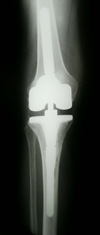 Revision components usually have longer stems that insert into the bones.
Revision components usually have longer stems that insert into the bones.
How long a knee replacement lasts depends on several factors, including activity level, weight, and general health. Just as wear in the natural joint contributed to the need for a replacement, wear in the implant may eventually require a second surgery (called a joint revision).
In a revision procedure, some or all of the parts of the original implant are removed and replaced with new components.
Revision components typically have longer stems which fit into the femur and tibia. They may also have attached metal pieces called augments which substitute for missing bone.
Revision components often have a cam in the center of the knee similar to a posterior stabilized component. In revision components, though, the cam is larger to give the knee more stability.
In cases where the knee is very unstable and a large amount of bone is missing, it may be necessary to join the femur and tibia with a metal "hinge" in the center.
Source: http://orthoinfo.aaos.org/topic.cfm?topic=A00221
